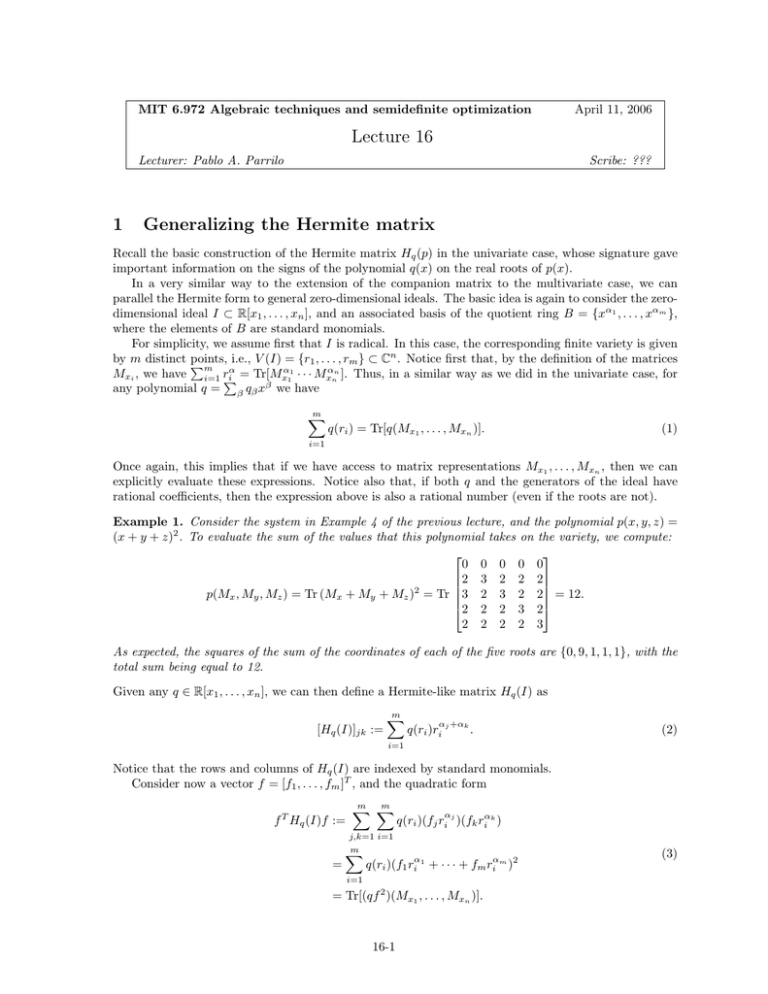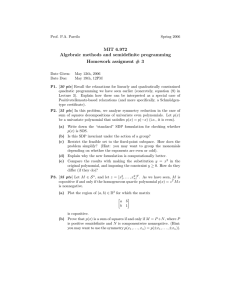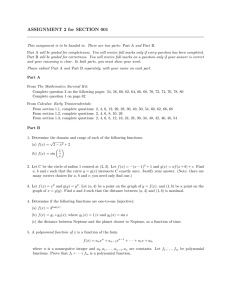Lecture 16
advertisement

MIT 6.972 Algebraic techniques and semidefinite optimization
April 11, 2006
Lecture 16
Lecturer: Pablo A. Parrilo
1
Scribe: ???
Generalizing the Hermite matrix
Recall the basic construction of the Hermite matrix Hq (p) in the univariate case, whose signature gave
important information on the signs of the polynomial q(x) on the real roots of p(x).
In a very similar way to the extension of the companion matrix to the multivariate case, we can
parallel the Hermite form to general zero­dimensional ideals. The basic idea is again to consider the zero­
dimensional ideal I ⊂ R[x1 , . . . , xn ], and an associated basis of the quotient ring B = {xα1 , . . . , xαm },
where the elements of B are standard monomials.
For simplicity, we assume first that I is radical. In this case, the corresponding finite variety is given
n
by m distinct points,
�m αi.e., V (I) α=1 {r1 , . .α.n, rm } ⊂ C . Notice first that, by the definition of the matrices
Mxi , we have i=1 r�
i = Tr[Mx1 · · · Mxn ]. Thus, in a similar way as we did in the univariate case, for
any polynomial q = β qβ xβ we have
m
�
q(ri ) = Tr[q(Mx1 , . . . , Mxn )].
(1)
i=1
Once again, this implies that if we have access to matrix representations Mx1 , . . . , Mxn , then we can
explicitly evaluate these expressions. Notice also that, if both q and the generators of the ideal have
rational coefficients, then the expression above is also a rational number (even if the roots are not).
Example 1. Consider the system in Example 4 of the previous lecture, and the polynomial p(x, y, z) =
(x + y + z)2 . To evaluate the sum of the values that this polynomial takes on the variety, we compute:
⎡
⎤
0 0 0 0 0
⎢2 3 2 2 2⎥
⎢
⎥
2
⎥
p(Mx , My , Mz ) = Tr (Mx + My + Mz ) = Tr ⎢
⎢3 2 3 2 2⎥ = 12.
⎣2 2 2 3 2⎦
2 2 2 2 3
As expected, the squares of the sum of the coordinates of each of the five roots are {0, 9, 1, 1, 1}, with the
total sum being equal to 12.
Given any q ∈ R[x1 , . . . , xn ], we can then define a Hermite­like matrix Hq (I) as
[Hq (I)]jk :=
m
�
α +αk
q(ri )ri j
.
(2)
i=1
Notice that the rows and columns of Hq (I) are indexed by standard monomials.
Consider now a vector f = [f1 , . . . , fm ]T , and the quadratic form
f T Hq (I)f :=
m �
m
�
α
q(ri )(fj ri j )(fk riαk )
j,k=1 i=1
=
m
�
q(ri )(f1 riα1 + · · · + fm riαm )2
i=1
= Tr[(qf 2 )(Mx1 , . . . , Mxn )].
16­1
(3)
As we see, the matrix Hq (I) is a specific representation,
�m in a 2basis given by standard monomials,
of a quadratic form Hq : C[x]/I → C, with Hq : f →
i=1 (qf )(ri ). The expressions in (3) allow
us to explicitly compute a matrix representation of this quadratic map. (What is the other “natural”
representation of this map?)
The following theorem then generalizes the results of the univariate case, and enable, among other
things, to do root counting.
Theorem 2. The signature of the matrix Hq (I) is equal to the number of real points ri in V (I) for
which q(ri ) > 0, minus the number of real points for which q(ri ) < 0.
Corollary 3. Consider a zero dimensional ideal I. The signature of the matrix H1 (I) is equal to the
number of real roots, i.e., |V (I) ∩ Rn |.
In the general (non­radical) case, we would take the property (3) as the definition of Hq (I), instead
of (2). Also, in Theorem 2, multiple real zeros are counted only once.
2
Parametric versions
One of the most appealing properties of Groebner­based eigenvalue methods is that they allow us to
extend many of the results to the parametric case, i.e., when we are interested in obtaining all solutions
of a polynomial system as a function of some additional parameters ηi .
Consider for simplicity the case of a single parameter η, and a polynomial system defined by pi (x, η) =
0. In order to solve this for any fixed η, we need to compute a Groebner basis of the corresponding
ideal. However, when η changes, it is possible that the resulting set of polynomials is no longer a GB. A
way of fixing this inconvenience is to compute instead a comprehensive Groebner basis, which is a set of
polynomials with the the property that it remains a Groebner basis of I for all possible specializations
of the parameters. Using the corresponding monomials as a basis for the quotient space, we can give an
eigenvalue characterization of the solutions for all values of η.
3
SOS on quotients
For simplicity, we assume throughout that the ideal I is radical. We can interpret the previous result as
essentially stating the fact that when a polynomial is nonnegative on a finite variety, then it is a sum of
squares on the quotient ring; see [Par02].
Theorem 4. Let f (x) be nonnegative on {x ∈ Rn |hi (x) = 0}. If the ideal I = �h1 , . . . , hm � is radical,
then f (x) is a sum of squares in the quotient ring R[x]/I, i.e.. there exist polynomials qi , λi , such that
f (x) =
�
qi2 (x) +
i
m
�
λi (x)hi (x).
i=1
Remark 5. The assumption that I is radical (or a suitable local modification) is necessary when f (x) is
nonnegative but not strictly positive. For instance, the polynomial f = x is nonnegative over the variety
defined by the (non­radical) ideal �x2 �, although no decomposition of the form x = s0 (x) + λ(x)x2 (where
s0 is SOS), can possibly exist.
References
[Par02] P. A. Parrilo. An explicit construction of distinguished representations of polynomials non­
negative over finite sets. Technical Report IfA Technical Report AUT02­02. Available from
http://control.ee.ethz.ch/~parrilo, ETH Zürich, 2002.
16­2






